 |
|
|
Location of seat: King William Courthouse
County Established: 1702
Present Courthouse Built: 1725
|
|
King William County's courthouse is the oldest in Virginia, and is the oldest courthouse building in the United States in continuous use (likely the oldest building in continuous use in the United States): Six of the seven oldest US courthouses in countinuous use are in Virginia counties, but number two is the Old Salem County Courthouse in New Jersey, which was built in 1735. |
|
 |
|
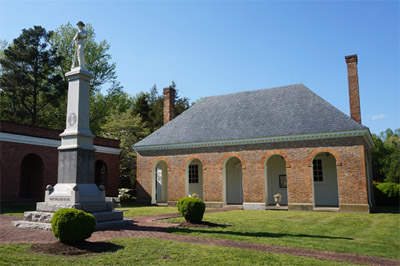   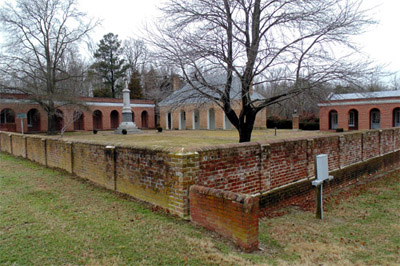 One of the things that makes the King William County Courthouse so special is the low wall that still surrounds it...many Virginia courthouses had such walls, but King William's may be the only one left fully intact. One of the things that makes the King William County Courthouse so special is the low wall that still surrounds it...many Virginia courthouses had such walls, but King William's may be the only one left fully intact. |
 |
King William County was established in 1702, from King and Queen County, which had broken off from New Kent County in 1691, which had broken off from York County in 1654, which had broken off from Charles River Shire, one of Virginia's original eight shires, in 1634. King William County was named for England's King William III (1650-1702). 
The town of West Point, with its all-important port where the Pamunkey and Mattaponi Rivers meet to make the York River, was the closest thing to a city that King William County had at its inception, but a county's courthouse was ideally placed as close to the center of the county as possible...plus courthouses were generally built wherever land was donated for their use, and such land was made available to King William County's justices by Richard Littlepage and Henry Fox, the county's first presiding justice. The Fox family was one of several owners of the tavern that sat just to the east of the courthouse. County Clerks didn't start getting their own dedicated offices until the late 18th century, with the county's court records being kept in the courthouse or sometimes even in the nearby tavern. King William County's first Clerk's Office was built to the courthouse's immediate right. |  |
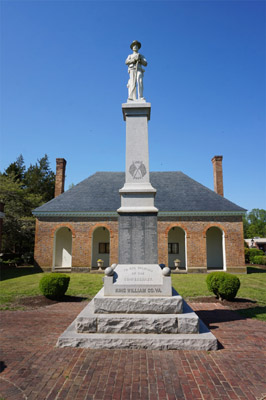
King William County's Confederate Monument is front & center, but somewhat unusually for Virginia courthouses, there are no markers honoring the dead from other wars: There is a monument to King William's war dead in a cemetery in West Point, but perhaps the decision was made to keep King William's courthouse green as colonial-looking as possible...albeit with a Civil War monument! |
|
 |
Sadly, this Clerk's Office burned down on January 17, 1885, and most of the county's court records went with it: King William County is consequently considered to be a Burned Record County. The county had insured its Clerk's Office to the tune of $1200, however, and in short order found itself with a new Clerk's Office and a new jail! This was fortunate indeed, as the county's "old jail" had by this time been recognized to be "insecure." The new jail was built where the Clerk's Office had been, and the new Clerk's Office was placed directly to the courthouse's left. Fire being the scourge to court records that it unquestionably was, companies selling "fireproof vaults" got lots of business in Virginia's counties toward the end of the 19th century. King William County's vault, which encloses about a quarter of the building's interior, presently holds many of the exhibits of the King William County Museum, which occupies the Clerk's Office. 
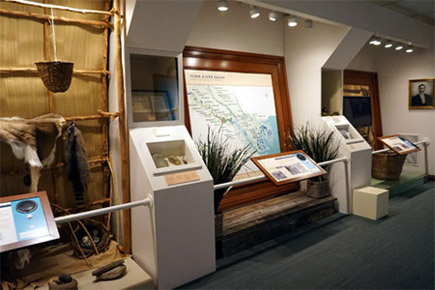 
The jail that today sits to King William Courthouse's right was built in 1890, which suggests that something untoward happened to that jail which had been completed in April of 1885. The 1890 jail trundled along in its intended role for 60 years, but by 1947 had been abandoned, and was described as "approaching the status of an eyesore." The county refurbished the jail a smidge and used it as a jury room, as things were getting cramped in the courthouse.
|
 |
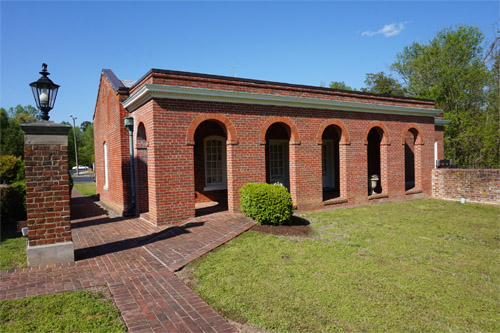 King William County's jail, which is today the home of the King William County Historical Sociery. King William County's jail, which is today the home of the King William County Historical Sociery.

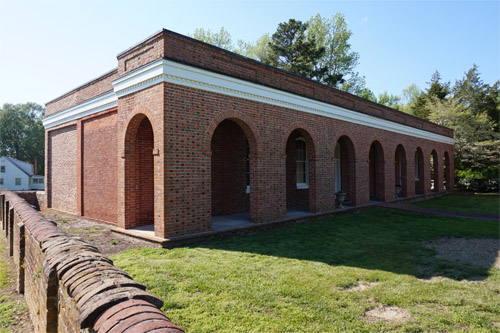
King William County's Clerk's Office, complete with fireproof vault! The county's museum is in this building today.
|
 The low brick wall that surrounds King William County's courthouse green was built in 1840. Such walls were necessary to keep cattle, which assumedly roamed everywhere with impunity in the mid-19th century, out of this important governmental space. Most of Virginia's county courthouses had such walls, and I've seen the remains of walls at nearly all of the courthouses I've visited, but King William's is the only one I've found to be fully intact.  |
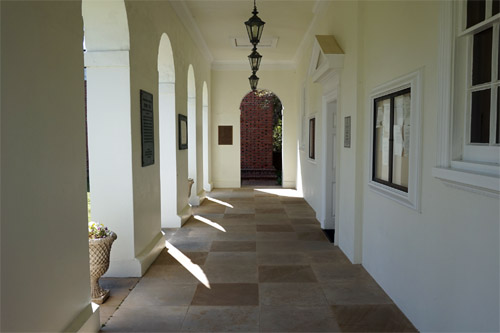 King William County Courthouse's lovely portico. On the walls of this space are markers dedicated to Henry Fox and Henry Jenner Jones, a local boy who was killed at the Battle of New Market in May of 1865. King William County Courthouse's lovely portico. On the walls of this space are markers dedicated to Henry Fox and Henry Jenner Jones, a local boy who was killed at the Battle of New Market in May of 1865. |
 |
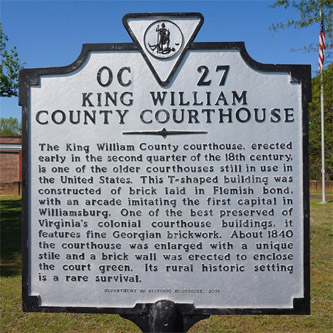
|
The only thing that King William County is missing from the classic Virginia courthouse tableau of courthouse, clerk's office, jail, low surrounding wall, Confederate monument and tavern, is the tavern. There of course was a tavern, which stood just to the east of the courthouse complex in what is now a wooded area. This tavern was known by many names, as it took the name of its present owner: The Bickerley, Gregory and the aforementioned Fox families (among others) owned the tavern over the years.
King William Courthouse was also served by the King William Courthouse Hotel, which was to the west of the courthouse complex. This hotel was in operation during the Civil War, and was for a time owned by Augustine Browne Hill, who also served as the county's Jailor. The hotel burned down in March of 1896.
Today, King William County's courtroom functions are held in a modern complex to the southeast of the historic courthouse, but some hearings are still held in the old courthouse, so as to maintain its status as oldest in continuous use. |
 |
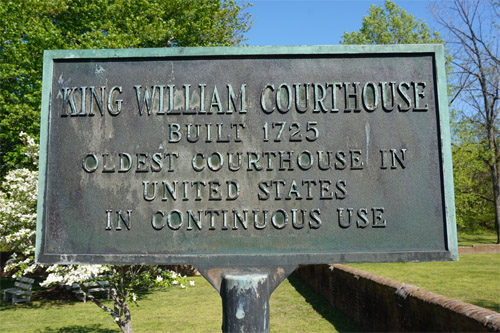 Harboring doubts that King William County's Courthouse is the oldest still in continuous use in the United States? May I direct you to this sturdy sign, whose veracity is unquestionable. There's an even older version of this "oldest" sign on display in the courthouse's portico: Click here to see it. Harboring doubts that King William County's Courthouse is the oldest still in continuous use in the United States? May I direct you to this sturdy sign, whose veracity is unquestionable. There's an even older version of this "oldest" sign on display in the courthouse's portico: Click here to see it. |
Many thanks to Anne Jackson of the King William County Museum for her help with this page! |
|
 |
|



